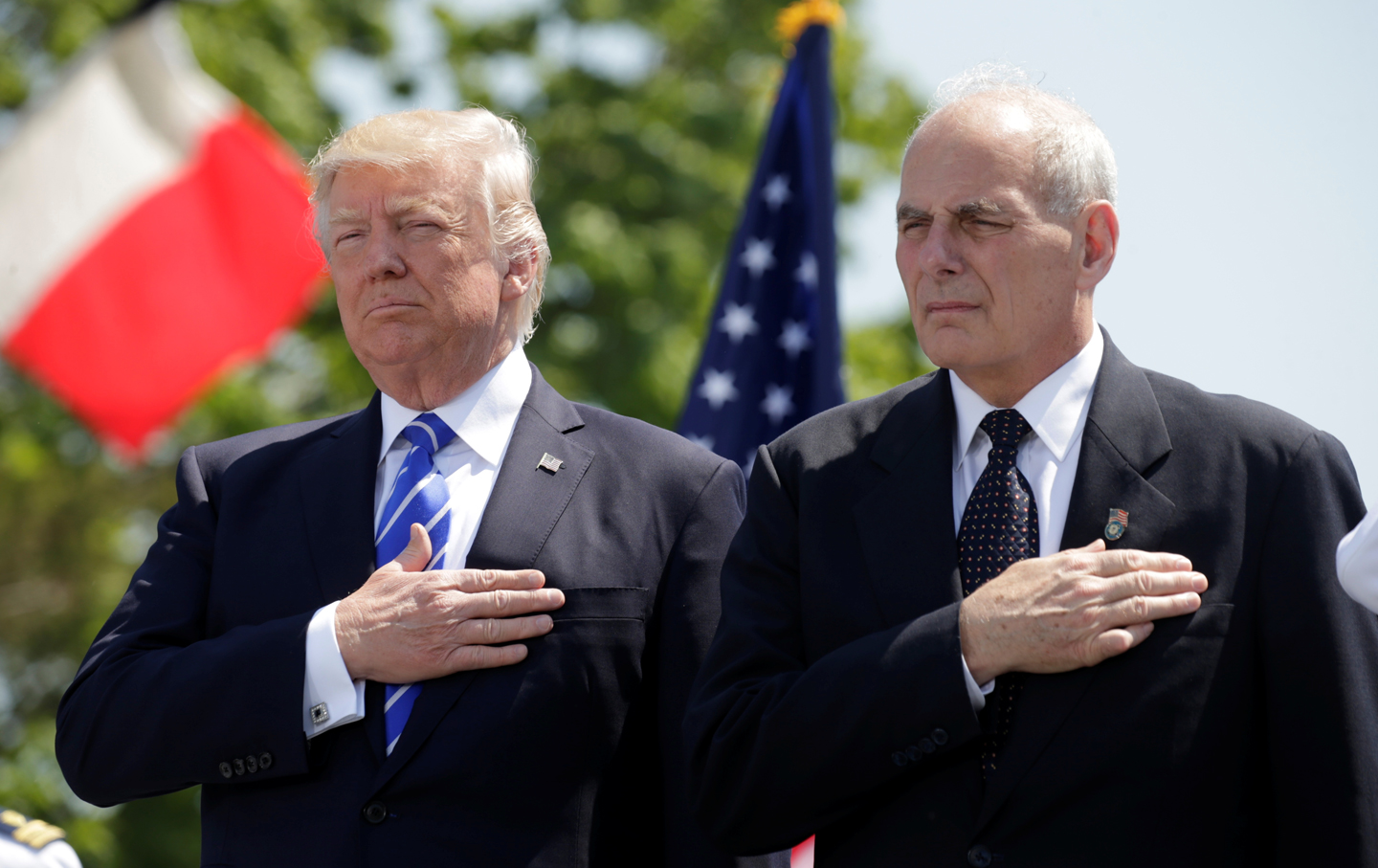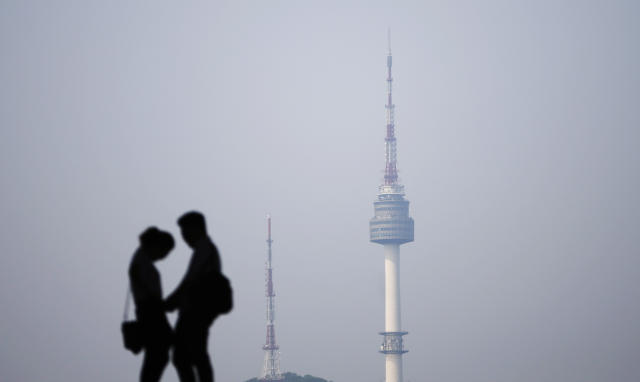The Nation
Meet John Kelly, Donald Trump’s New Enabler in Chief
Kelly has a record of coddling Trump—and no good will come of that.
By John Nichols July 28, 2017

Donald Trump and John Kelly attend the Coast Guard Academy commencement ceremonies, May 17, 2017. (Reuters / Kevin Lamarque)
Reince Priebus was a miserable White House chief of staff. A political hack who was lousy on television, ineffectual on Capitol Hill, and disrespected by the president who hired him, Priebus devolved into such a sad case that the highlight of his six-month tenure came when he was allowed to share the stage at the Conservative Political Action Conference with someone who actually enjoyed the respect of Donald Trump: Steve Bannon.
But at least Priebus had a measure of self respect. There was evidence to suggest there were some things he would not do and some people (starting with Anthony Scaramucci) to whom he would not bend. That was part of what prevented Trump—who, as Attorney General Jeff Sessions has learned, demands absolute loyalty—from bonding with the man who on most White House organization charts should have been the president’s right-hand man.
There will be no such “problem” with the man who on Monday will replace Priebus. Homeland Security Secretary John Kelly, the retired United States Marine Corps general who will become the second White House chief of staff in the first year of Trump’s presidency, is an absolute apologist for this president.
Kelly is an outspoken and over-the-top Trump loyalist who announced to a February House Homeland Security Committee oversight session that “I work for one man. His name is Donald Trump.”
Translation: Even if Kelly disagrees with a policy, even if he has doubts about whether Trump is doing the right thing, he was not going to share those anxieties with the members of Congress who are charged with overseeing the executive branch. The question is whether he will share those anxieties with Trump himself; and Kelly’s record does not inspire confidence.
Kelly likes to present himself as a bold truth teller. He got good marks when he told the Senate Homeland Security and Governmental Affairs Committee, “I have never had a problem speaking truth to power, and I firmly believe that those in power deserve full candor and my honest assessment and recommendations.” But once he joined the cabinet, however, Kelly made himself over as a cheerleader for Trump and Trumpism.
What attracted Trump to Kelly was not the retired general’s candor. It was, as usual with Trump, an area of agreement. Kelly’s linking of border-security issues with the “War of Terror” reportedly got Trump and his transition team excited about hiring the general. While serving as head of the US Southern Command, the general told a 2015 Senate Armed Services Committee hearing that “Terrorist organizations could seek to leverage those same smuggling routes (in Central American and Mexico) to move operatives with intent to cause grave harm to our citizens or even bring weapons of mass destruction into the United States.
That was bold language—“a little over the top,” in the view of Frank Sharry, the executive director of the immigration-reform group America’s Voice. But members of the Senate comforted themselves with the expectation that Kelly’s experience with national-security issues would lead him to speak truth to Trump’s power on the issues of immigration policy, deportations, border walls, Muslim bans, and domestic policing that are within the purview of the Department of Homeland Security. But after the Senate approved Kelly’s nomination, the general lost his voice. He did not speak truth to power. Rather, he reinforced power that would have been better served by blunt questioning and open objection.
In late January 2017, after the rollout of the president’s executive order banning travel from seven Muslim countries went horribly awry—with mass protests, immediate legal challenges, judicial orders blocking its implementation, and an international outcry—Kelly was called before Congress to explain the whys and wherefores of the chaos. “This is all on me,” the secretary announced, taking full blame for the failed attempt to impose a religious-test restriction on refugees and visitors that critics correctly labeled as a “Muslim ban.”
That may have sounded like an honorable acceptance of responsibility when no one else in the administration was acting responsibly. But when a member of the cabinet speaks to Congress they are supposed to give a clear and accurate assessment of what has transpired. And no clear or accurate assessment of what transpired with the Muslim ban would place responsibility on John Kelly.
Despite his public apologias for the administration, the fact is that the Muslim ban was never “all on” Kelly. Quite the opposite. The travel ban was, by virtually all accounts, the work of White House strategists Bannon and Stephen Miller. Indeed, a Wall Street Journal report based on leaks from inside the administration suggested that: “Mr. Kelly was also frustrated at not knowing the details of the travel ban earlier, so he could prepare his agency to respond, according to people familiar with the matter. Mr. Trump signed the executive order that created the ban late Friday afternoon. Mr. Kelly was only informed of the details that day as he was traveling to Washington, even though he had pressed the White House for days to share with him the final language, the people said.”
“The tensions between DHS and the White House have led to uncertainty at the top of an agency charged with keeping Americans safe within US borders. The agency struggled to respond to demonstrations and scenes of confusion at various airports after the immigration order,” explained the Journal article, which noted that, “Even though he was not involved in the order’s preparation, Mr. Kelly was peppered with questions about it. Democrat Senate Minority Leader Charles Schumer spoke with Mr Kelly twice at the time to press for details.”
The newspaper suggested that “The problems at DHS reflect a growing unease among government workers with a series of abrupt policy changes dictated by a close-knit group inside the West Wing of the White House.”
Kelly did not acknowledge those tensions when he appeared before the House committee. Indeed, he downplayed press reports about clashes with Bannon and tried to paint a picture of smooth relations that strained credulity. His “I work for one man” response to questions from the committee was another way of saying that frankness was not on the agenda. He is so loyal to Trump that he will not even acknowledge reality.
When Kelly asked in early March about Trump’s allegation that President Barack Obama ordered the wiretapping of Trump Tower phones during the 2016 campaign. Trump’s charge was explicit and exceptionally serious. “Terrible! Just found out that Obama had my “wires tapped” in Trump Tower just before the victory. Nothing found. This is McCarthyism!” the president tweeted on March 4. He even outlined legal remedies, tweeting: “Is it legal for a sitting President to be “wire tapping” a race for president prior to an election? Turned down by court earlier. A NEW LOW!” and “I’d bet a good lawyer could make a great case out of the fact that President Obama was tapping my phones in October, just prior to Election!” Obama, Trump asserted, had undermined “the very sacred election process. This is Nixon/Watergate. Bad (or sick) guy!”
There was one problem with the charge, which the president apparently picked up from right-wing Internet chatter. There was no credible evidence to back it up. None. By all accounts, the alleged wiretapping had not occurred.
Kelly admitted, when he appeared on CNN on the following Monday, that he had nothing to add to the discussion. “I don’t know anything about it,” the top national-security figure told CNN’s Wolf Blitzer. But then Kelly went off the rails.
“If the President of the United States said that, he’s got his reasons to say it,” the secretary of homeland security announced. “He must have some convincing evidence that took place… I don’t pretend to even guess as to what the motivation may have been for the previous administration to do something like that.”
When Kelly used the term “for the previous administration to do something like that,” he was effectively asserting that the wiretapping had either occurred or, at the least, was likely to have occurred. Yet former director of national intelligence James Clapper was already saying, “There was no wiretap against Trump Tower during the campaign conducted by any part of the National Intelligence Community.” Former CIA and NSA director General Michael Hayden was saying that there was “no body of evidence” for Trump’s claim that Obama ordered those election-season wiretaps.
What was John Kelly thinking?
The answer is that he was not thinking. He was simply covering for the president—doing his “work for one man”: Donald Trump. Everyone knows that one man needs to be challenged and confronted with reality. Unfortunately, John Kelly does not have a record of challenging or confronting the president’s absurd assertions. Kelly has a record of coddling Trump, and no good will come of that.
John Nichols is The Nation’s national-affairs correspondent. He is the author of Horsemen of the Trumpocalypse: A Field Guide to the Most Dangerous People in America, forthcoming from Nation Books this fall, and co-author, with Robert W. McChesney, of People Get Ready: The Fight Against a Jobless Economy and a Citizenless Democracy.







